Cristian Borcea
Using Salient Object Detection to Identify Manipulative Cookie Banners that Circumvent GDPR
Oct 30, 2025Abstract:The main goal of this paper is to study how often cookie banners that comply with the General Data Protection Regulation (GDPR) contain aesthetic manipulation, a design tactic to draw users' attention to the button that permits personal data sharing. As a byproduct of this goal, we also evaluate how frequently the banners comply with GDPR and the recommendations of national data protection authorities regarding banner designs. We visited 2,579 websites and identified the type of cookie banner implemented. Although 45% of the relevant websites have fully compliant banners, we found aesthetic manipulation on 38% of the compliant banners. Unlike prior studies of aesthetic manipulation, we use a computer vision model for salient object detection to measure how salient (i.e., attention-drawing) each banner element is. This enables the discovery of new types of aesthetic manipulation (e.g., button placement), and leads us to conclude that aesthetic manipulation is more common than previously reported (38% vs 27% of banners). To study the effects of user and/or website location on cookie banner design, we include websites within the European Union (EU), where privacy regulation enforcement is more stringent, and websites outside the EU. We visited websites from IP addresses in the EU and from IP addresses in the United States (US). We find that 13.9% of EU websites change their banner design when the user is from the US, and EU websites are roughly 48.3% more likely to use aesthetic manipulation than non-EU websites, highlighting their innovative responses to privacy regulation.
CryptGNN: Enabling Secure Inference for Graph Neural Networks
Sep 11, 2025Abstract:We present CryptGNN, a secure and effective inference solution for third-party graph neural network (GNN) models in the cloud, which are accessed by clients as ML as a service (MLaaS). The main novelty of CryptGNN is its secure message passing and feature transformation layers using distributed secure multi-party computation (SMPC) techniques. CryptGNN protects the client's input data and graph structure from the cloud provider and the third-party model owner, and it protects the model parameters from the cloud provider and the clients. CryptGNN works with any number of SMPC parties, does not require a trusted server, and is provably secure even if P-1 out of P parties in the cloud collude. Theoretical analysis and empirical experiments demonstrate the security and efficiency of CryptGNN.
FedX: Adaptive Model Decomposition and Quantization for IoT Federated Learning
Apr 19, 2025Abstract:Federated Learning (FL) allows collaborative training among multiple devices without data sharing, thus enabling privacy-sensitive applications on mobile or Internet of Things (IoT) devices, such as mobile health and asset tracking. However, designing an FL system with good model utility that works with low computation/communication overhead on heterogeneous, resource-constrained mobile/IoT devices is challenging. To address this problem, this paper proposes FedX, a novel adaptive model decomposition and quantization FL system for IoT. To balance utility with resource constraints on IoT devices, FedX decomposes a global FL model into different sub-networks with adaptive numbers of quantized bits for different devices. The key idea is that a device with fewer resources receives a smaller sub-network for lower overhead but utilizes a larger number of quantized bits for higher model utility, and vice versa. The quantization operations in FedX are done at the server to reduce the computational load on devices. FedX iteratively minimizes the losses in the devices' local data and in the server's public data using quantized sub-networks under a regularization term, and thus it maximizes the benefits of combining FL with model quantization through knowledge sharing among the server and devices in a cost-effective training process. Extensive experiments show that FedX significantly improves quantization times by up to 8.43X, on-device computation time by 1.5X, and total end-to-end training time by 1.36X, compared with baseline FL systems. We guarantee the global model convergence theoretically and validate local model convergence empirically, highlighting FedX's optimization efficiency.
Demo: SGCode: A Flexible Prompt-Optimizing System for Secure Generation of Code
Sep 11, 2024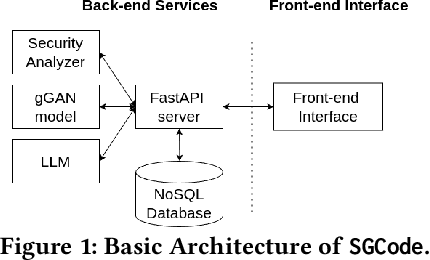

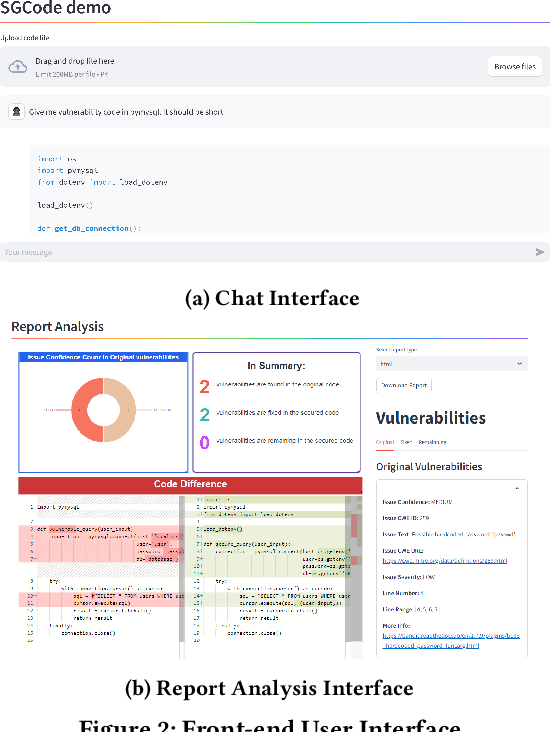
Abstract:This paper introduces SGCode, a flexible prompt-optimizing system to generate secure code with large language models (LLMs). SGCode integrates recent prompt-optimization approaches with LLMs in a unified system accessible through front-end and back-end APIs, enabling users to 1) generate secure code, which is free of vulnerabilities, 2) review and share security analysis, and 3) easily switch from one prompt optimization approach to another, while providing insights on model and system performance. We populated SGCode on an AWS server with PromSec, an approach that optimizes prompts by combining an LLM and security tools with a lightweight generative adversarial graph neural network to detect and fix security vulnerabilities in the generated code. Extensive experiments show that SGCode is practical as a public tool to gain insights into the trade-offs between model utility, secure code generation, and system cost. SGCode has only a marginal cost compared with prompting LLMs. SGCode is available at: http://3.131.141.63:8501/.
Concept Matching: Clustering-based Federated Continual Learning
Nov 12, 2023Abstract:Federated Continual Learning (FCL) has emerged as a promising paradigm that combines Federated Learning (FL) and Continual Learning (CL). To achieve good model accuracy, FCL needs to tackle catastrophic forgetting due to concept drift over time in CL, and to overcome the potential interference among clients in FL. We propose Concept Matching (CM), a clustering-based framework for FCL to address these challenges. The CM framework groups the client models into concept model clusters, and then builds different global models to capture different concepts in FL over time. In each round, the server sends the global concept models to the clients. To avoid catastrophic forgetting, each client selects the concept model best-matching the concept of the current data for further fine-tuning. To avoid interference among client models with different concepts, the server clusters the models representing the same concept, aggregates the model weights in each cluster, and updates the global concept model with the cluster model of the same concept. Since the server does not know the concepts captured by the aggregated cluster models, we propose a novel server concept matching algorithm that effectively updates a global concept model with a matching cluster model. The CM framework provides flexibility to use different clustering, aggregation, and concept matching algorithms. The evaluation demonstrates that CM outperforms state-of-the-art systems and scales well with the number of clients and the model size.
Complement Sparsification: Low-Overhead Model Pruning for Federated Learning
Mar 10, 2023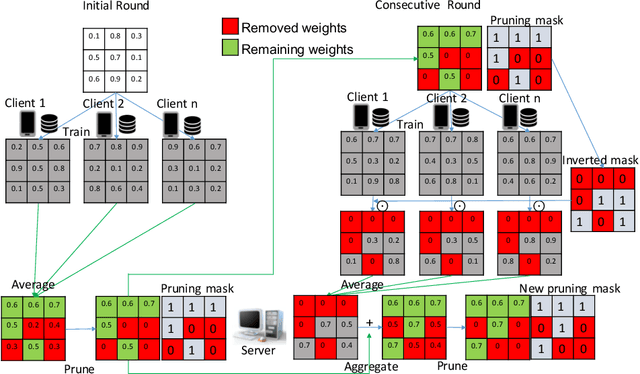

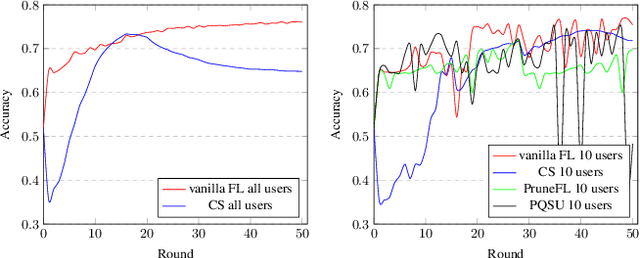

Abstract:Federated Learning (FL) is a privacy-preserving distributed deep learning paradigm that involves substantial communication and computation effort, which is a problem for resource-constrained mobile and IoT devices. Model pruning/sparsification develops sparse models that could solve this problem, but existing sparsification solutions cannot satisfy at the same time the requirements for low bidirectional communication overhead between the server and the clients, low computation overhead at the clients, and good model accuracy, under the FL assumption that the server does not have access to raw data to fine-tune the pruned models. We propose Complement Sparsification (CS), a pruning mechanism that satisfies all these requirements through a complementary and collaborative pruning done at the server and the clients. At each round, CS creates a global sparse model that contains the weights that capture the general data distribution of all clients, while the clients create local sparse models with the weights pruned from the global model to capture the local trends. For improved model performance, these two types of complementary sparse models are aggregated into a dense model in each round, which is subsequently pruned in an iterative process. CS requires little computation overhead on the top of vanilla FL for both the server and the clients. We demonstrate that CS is an approximation of vanilla FL and, thus, its models perform well. We evaluate CS experimentally with two popular FL benchmark datasets. CS achieves substantial reduction in bidirectional communication, while achieving performance comparable with vanilla FL. In addition, CS outperforms baseline pruning mechanisms for FL.
Zone-based Federated Learning for Mobile Sensing Data
Mar 10, 2023

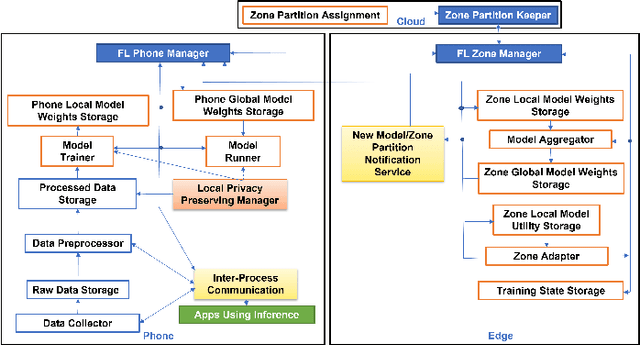

Abstract:Mobile apps, such as mHealth and wellness applications, can benefit from deep learning (DL) models trained with mobile sensing data collected by smart phones or wearable devices. However, currently there is no mobile sensing DL system that simultaneously achieves good model accuracy while adapting to user mobility behavior, scales well as the number of users increases, and protects user data privacy. We propose Zone-based Federated Learning (ZoneFL) to address these requirements. ZoneFL divides the physical space into geographical zones mapped to a mobile-edge-cloud system architecture for good model accuracy and scalability. Each zone has a federated training model, called a zone model, which adapts well to data and behaviors of users in that zone. Benefiting from the FL design, the user data privacy is protected during the ZoneFL training. We propose two novel zone-based federated training algorithms to optimize zone models to user mobility behavior: Zone Merge and Split (ZMS) and Zone Gradient Diffusion (ZGD). ZMS optimizes zone models by adapting the zone geographical partitions through merging of neighboring zones or splitting of large zones into smaller ones. Different from ZMS, ZGD maintains fixed zones and optimizes a zone model by incorporating the gradients derived from neighboring zones' data. ZGD uses a self-attention mechanism to dynamically control the impact of one zone on its neighbors. Extensive analysis and experimental results demonstrate that ZoneFL significantly outperforms traditional FL in two models for heart rate prediction and human activity recognition. In addition, we developed a ZoneFL system using Android phones and AWS cloud. The system was used in a heart rate prediction field study with 63 users for 4 months, and we demonstrated the feasibility of ZoneFL in real-life.
FLSys: Toward an Open Ecosystem for Federated Learning Mobile Apps
Nov 21, 2021
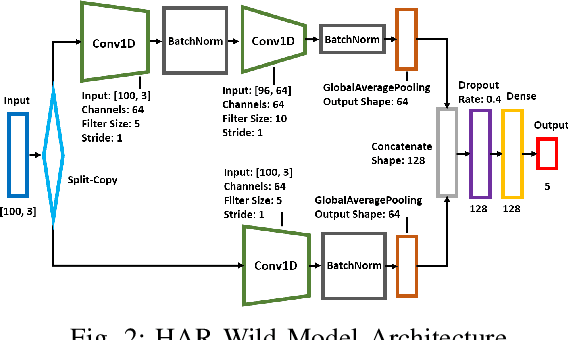
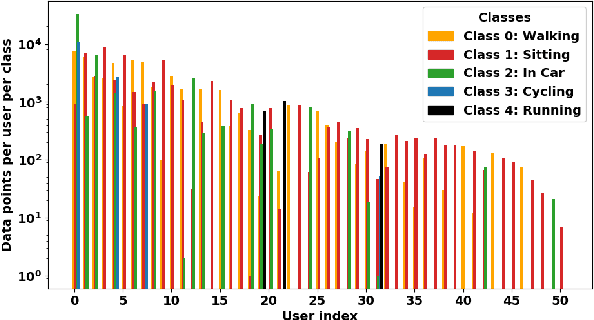
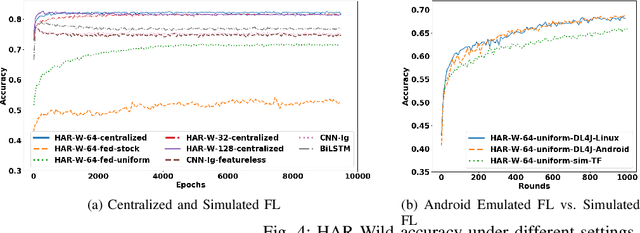
Abstract:This paper presents the design, implementation, and evaluation of FLSys, a mobile-cloud federated learning (FL) system that supports deep learning models for mobile apps. FLSys is a key component toward creating an open ecosystem of FL models and apps that use these models. FLSys is designed to work with mobile sensing data collected on smart phones, balance model performance with resource consumption on the phones, tolerate phone communication failures, and achieve scalability in the cloud. In FLSys, different DL models with different FL aggregation methods in the cloud can be trained and accessed concurrently by different apps. Furthermore, FLSys provides a common API for third-party app developers to train FL models. FLSys is implemented in Android and AWS cloud. We co-designed FLSys with a human activity recognition (HAR) in the wild FL model. HAR sensing data was collected in two areas from the phones of 100+ college students during a five-month period. We implemented HAR-Wild, a CNN model tailored to mobile devices, with a data augmentation mechanism to mitigate the problem of non-Independent and Identically Distributed (non-IID) data that affects FL model training in the wild. A sentiment analysis (SA) model is used to demonstrate how FLSys effectively supports concurrent models, and it uses a dataset with 46,000+ tweets from 436 users. We conducted extensive experiments on Android phones and emulators showing that FLSys achieves good model utility and practical system performance.
FGLP: A Federated Fine-Grained Location Prediction System for Mobile Users
Jun 13, 2021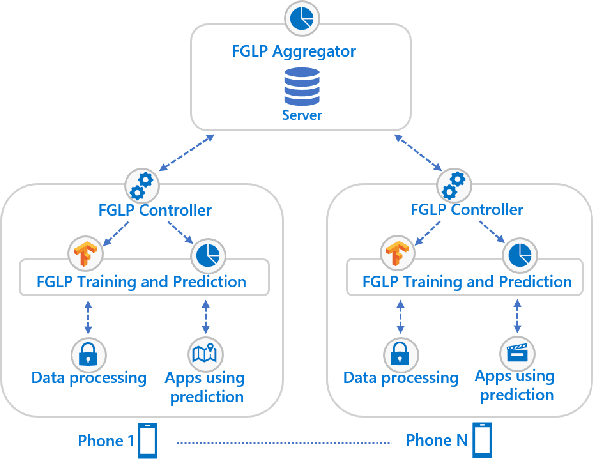
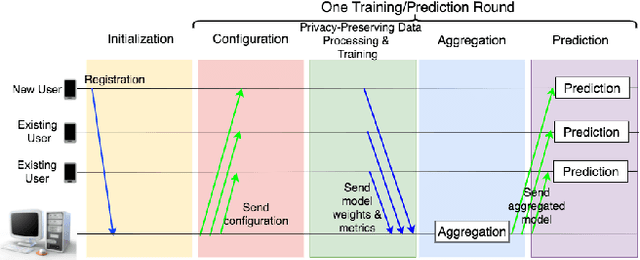
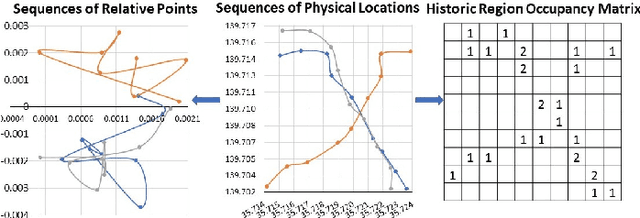
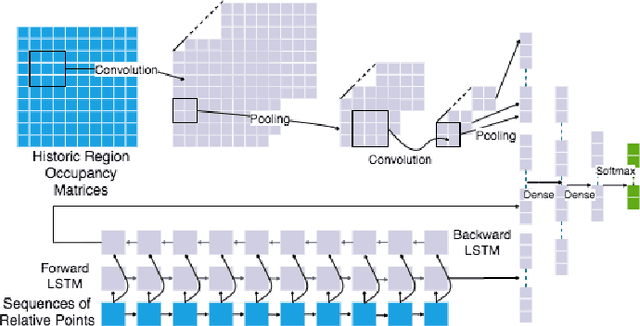
Abstract:Fine-grained location prediction on smart phones can be used to improve app/system performance. Application scenarios include video quality adaptation as a function of the 5G network quality at predicted user locations, and augmented reality apps that speed up content rendering based on predicted user locations. Such use cases require prediction error in the same range as the GPS error, and no existing works on location prediction can achieve this level of accuracy. We present a system for fine-grained location prediction (FGLP) of mobile users, based on GPS traces collected on the phones. FGLP has two components: a federated learning framework and a prediction model. The framework runs on the phones of the users and also on a server that coordinates learning from all users in the system. FGLP represents the user location data as relative points in an abstract 2D space, which enables learning across different physical spaces. The model merges Bidirectional Long Short-Term Memory (BiLSTM) and Convolutional Neural Networks (CNN), where BiLSTM learns the speed and direction of the mobile users, and CNN learns information such as user movement preferences. FGLP uses federated learning to protect user privacy and reduce bandwidth consumption. Our experimental results, using a dataset with over 600,000 users, demonstrate that FGLP outperforms baseline models in terms of prediction accuracy. We also demonstrate that FGLP works well in conjunction with transfer learning, which enables model reusability. Finally, benchmark results on several types of Android phones demonstrate FGLP's feasibility in real life.
Packaging and Sharing Machine Learning Models via the Acumos AI Open Platform
Oct 16, 2018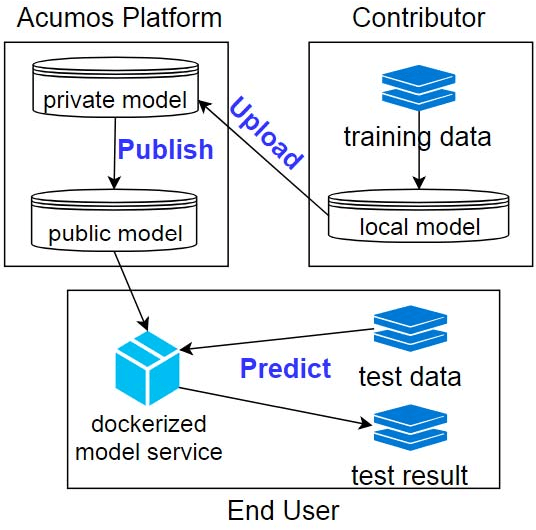
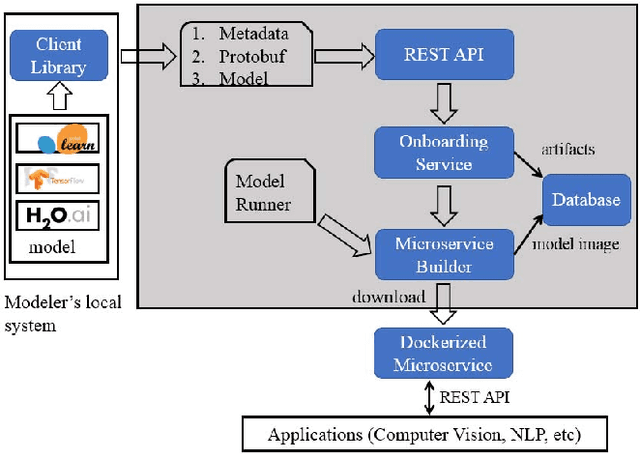
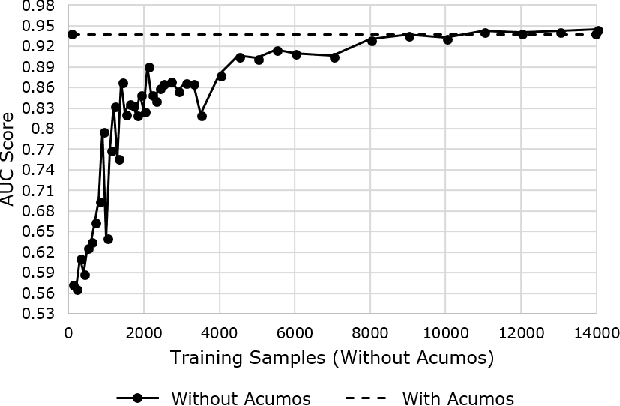
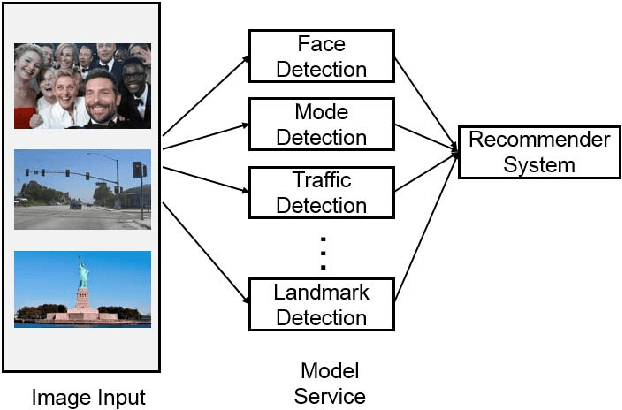
Abstract:Applying Machine Learning (ML) to business applications for automation usually faces difficulties when integrating diverse ML dependencies and services, mainly because of the lack of a common ML framework. In most cases, the ML models are developed for applications which are targeted for specific business domain use cases, leading to duplicated effort, and making reuse impossible. This paper presents Acumos, an open platform capable of packaging ML models into portable containerized microservices which can be easily shared via the platform's catalog, and can be integrated into various business applications. We present a case study of packaging sentiment analysis and classification ML models via the Acumos platform, permitting easy sharing with others. We demonstrate that the Acumos platform reduces the technical burden on application developers when applying machine learning models to their business applications. Furthermore, the platform allows the reuse of readily available ML microservices in various business domains.
 Add to Chrome
Add to Chrome Add to Firefox
Add to Firefox Add to Edge
Add to Edge